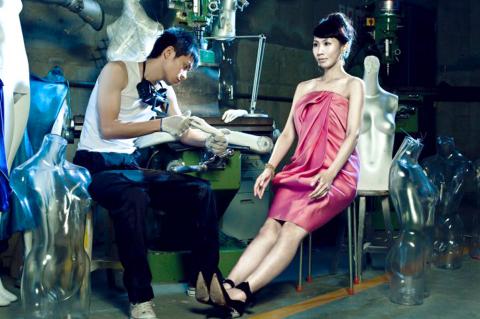Before heading to Japan’s Festival/Tokyo in November, Against Again Troupe gave a debut performance of its new work Eventually Withering Away Little by Little last week. The play experiments with the possibilities of a theater without people. The new work, being performed in celebration of the troupe’s 10th anniversary, will also be performed at this year’s Macau City Fringe Festival.
Combining various theatrical art forms, including object theater, installation art, sound art and behavior art, the play forms a theater without actors. The production will be put on by Against Again Theater’s five artists, including Joyce Ho, who won a special award at the KOBE Biennale, theater musician and director Chiang Tao, producer Lin Jen-chung, and artists Kappa Tseng and Wang Shih-chi. The five of them use their own individual performance methods to outline evidence that is supposed to prove the existence of a woman who is never actually present on the stage. The play creates limitless possibilities for its stream-of-consciousness narrative, paying tribute to one of the most important female writers of the 20th century — Virginia Woolf.
A theater of actors that does not actually use people was the brainchild of Against Again Troupe director, Huang Sze-nung. He says that the absence of others is something that every individual must experience in life, “Maybe people leave, perhaps they die, or maybe they are there the whole time but just not seen.”

Photo Courtesy of Against Again Troupe
照片:照片由再拒劇團提供
(Liberty Times, Translated by Kyle Jeffcoat)
十一月前往東京藝術節前夕,再拒劇團上週演出《接下來,是一些些消亡》的台灣首演,實驗無人劇場的可能性。該作品也將受邀澳門藝穗節演出,這也是今年成立十年的再拒劇團代表作。
結合了物件劇場、裝置藝術、聲音藝術、行為藝術等多樣戲劇型態,就是不能有「演員」,再拒劇團邀約五位藝術家包括獲得日本神戶雙年展評審特別賞的何采柔,劇場音樂雙棲鬼才導演蔣韜,製作人林人中,藝術家曾彥婷以及藝術家王詩琪。五人分別以自己的表現手法,勾勒出「不在場」的女子存在的證據,嘗試「意識流」劇場的無限可能,也同時向二十世紀最重要的女性小說家吳爾芙致敬。

Photo Courtesy of Against Again Troupe
照片由再拒劇團提供
這場無人演員的劇展由再拒劇團團長黃思農策劃,他表示,事實上,各種各樣他者的缺席,是每個人的生命所經歷的必然過程,「也許對方離開,也許死亡,也許一直都在,卻不被看見。」
(自由時報記者趙靜瑜)

Photo Courtesy of Against Again Troupe
照片由再拒劇團提供

A: Apart from the Taipei Music Center’s exhibit and concert, US pop rock band OneRepublic and rapper Doja Cat are touring Kaohsiung this weekend. B: OneRepublic is so popular that after tonight’s show at the K-Arena, they are set to return to Taiwan again in March next year. A: And Doja will also perform at the same venue on Sunday, right? B: Yup. Her collab with Blackpink’s Lisa and singer Raye for the song “Born Again” has been a huge worldwide success. A: Doja even made it on Time magazine’s “100 Most Influential People” list in 2023. She’s so cool. A: 本週末除了北流的特展和演唱會外,美國男團共和世代和饒舌歌手蜜桃貓朵佳也將來台開唱。 B: 共和世代因太受歡迎,繼今晚高雄巨蛋的演唱會後,預計明年3月即將再度來台巡演唷。 A: 朵佳本週日將在同場地開唱,對不對?

A: What show are you watching online? B: I’m watching “Fly Me to the Moon & Back” – an exhibition launched by the Taipei Music Center (TMC) to commemorate the late singer Tom Chang. A: Known for his sky-high notes, Chang is praised as one of the best singers in the 1990s. His death at the age of 31 was a major loss indeed. B: And I’m so glad that we went to the TMC’s 90s-themed concert last Friday. I finally saw the iconic “Godmother of Rock” WaWa perform live. A: This year-end show also featured singers Princess Ai, Bii, Wayne Huang, PoLin and

Just like fingerprints, your breathing patterns may serve as a definitive identifier. In a recent study, scientists have demonstrated an astonishing 96.8% accuracy in identifying individuals based on their respiratory patterns. This revelation could open up new possibilities in biometrics and personalized health monitoring. The notion of using individual breathing patterns as a distinct biological signature has long been a topic of discussion within the respiratory science community, yet a practical method for measurement remained elusive. This changed with the invention of a tiny, wearable device capable of extended recording. Researchers deployed a lightweight tube designed to fit inside

Continued from yesterday(延續自昨日) The study also uncovered a correlation between breathing patterns and mental well-being. Participants with higher scores on anxiety questionnaires exhibited shorter inhalation periods and more frequent breath pauses during sleep. “We intuitively assume that how depressed or anxious you are changes the way you breathe,” says one researcher involved in the study. “But it might be the other way around.” If this proves true, then training people to adjust their breathing may offer a novel approach to managing conditions like anxiety or depression. 該項研究也揭露了呼吸模式與心理健康之間的關聯。在焦慮問卷得分較高的受試者於睡眠期間表現出的吸氣時間較為短促、呼吸中止更為頻繁。一位參與研究的學者表示:「我們直覺地認為憂鬱或焦慮的程度會改變你的呼吸方式,但有可能是反過來的情況。」如果這一假設得到證實,那麼訓練人們調整呼吸的方式,可能會成為管理焦慮或憂鬱等疾病的新穎方法。 What Did You Learn? 1. What problem did scientists previously face when trying to measure breathing patterns? 2.